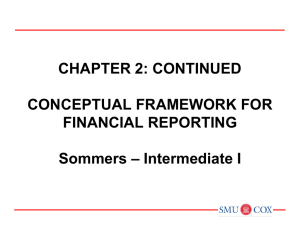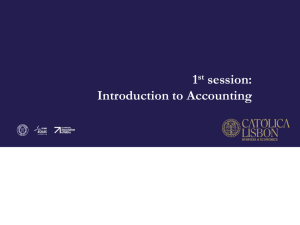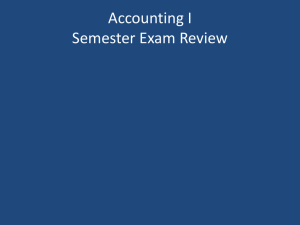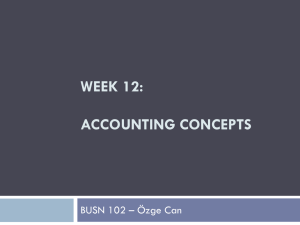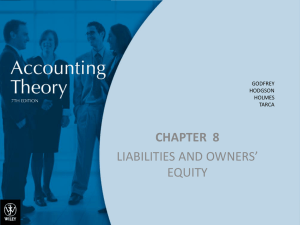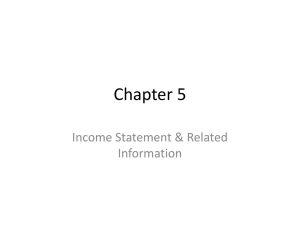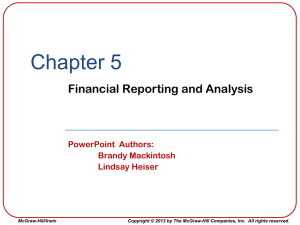After
advertisement
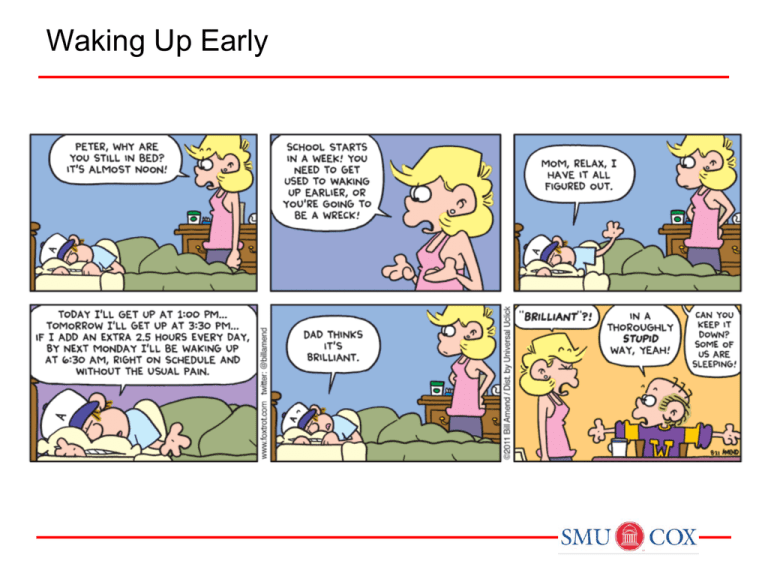
Waking Up Early CHAPTER 2: CONTINUED CONCEPTUAL FRAMEWORK FOR FINANCIAL REPORTING Sommers – ACCT 3311 In Accounting, Truth Above All • Who wrote it? Mr. Beresford was Ernst & Young’s Partner in Charge of Accounting Standards prior to his appointment as Chairman of the Financial Accounting Standards Board. In addition, he has served on the Board of Directors of such well-known organizations as KimberlyClark Corporation and Fannie Mae. • What is the assertion? • Do you agree? Second Level: Basic Elements Basic Elements Illustration 2-7 Conceptual Framework for Financial Reporting Second Level: Basic Elements Concepts Statement No. 6 defines ten interrelated elements that relate to measuring the performance and financial status of a business enterprise. “Moment in Time” Assets Liabilities Equity “Period of Time” Investment by owners Distribution to owners Comprehensive income Revenue Expenses Gains Losses Discussion Question Q2-10 Expenses, losses, and distributions to owners are all decreases in net assets. What are the distinctions among them? Distributions to owners differ from expenses and losses in that they represent transfers to owners, and they do not arise from activities intended to produce income. Expenses differ from losses in that they arise from the entity’s ongoing major or central operations. Losses arise from peripheral or incidental transactions. Second Level: Basic Elements Exercise 2-5: Identify the element or elements associated with items below. Elements Assets (a) Arises from peripheral or incidental transactions. (b) (b) Obligation to transfer resources arising from a past transaction. Equity (c) Increases ownership interest. (d) Declares and pays cash dividends to owners. Liabilities (e) (c) Investment by owners (d) Distribution to owners (c) Comprehensive income Revenue (e) Increases in net assets in a period from nonowner sources. Expenses (a) Gains (a) Losses Second Level: Basic Elements Exercise 2-5: Identify the element or elements associated with items below. Elements (f) Assets (f) Items characterized by future economic benefit. (g) Equals increase in net assets during the year, after adding distributions to owners and subtracting investments by owners. (h) Arises from income statement activities that constitute the entity’s ongoing major or central operations. Liabilities Equity Investment by owners Distribution to owners (g) (h) Comprehensive income (h) Expenses Revenue Gains Losses Second Level: Basic Elements Exercise 2-5: Identify the element or elements associated with items below. Elements Assets (i) Residual interest in the net assets of the enterprise. (j) Increases assets through sale of product. (k) Decreases assets by purchasing the company’s own stock. (l) Changes in equity during the period, except those from investments by owners and distributions to owners. Liabilities (i) Equity Investment by owners (k) Distribution to owners (l) Comprehensive income (j) Revenue Expenses Gains Losses Third Level: Recognition and Measurement The FASB sets forth most of these concepts in its Statement of Financial Accounting Concepts No. 5, “Recognition and Measurement in Financial Statements of Business Enterprises.” Illustration 2-7 Conceptual Framework for Financial Reporting Discussion Question Q2-12 What are the four basic assumptions that underlie the financial accounting structure? Third Level: Assumptions Economic Entity – company keeps its activity separate from its owners and other businesses. Going Concern - company to last long enough to fulfill objectives and commitments. Monetary Unit - money is the common denominator. Periodicity - company can divide its economic activities into time periods. Third Level: Assumptions Brief Exercise 2-7: Identify which basic assumption of accounting is best described in each item below. (a) The economic activities of KC Corporation are divided into 12-month periods for the purpose of issuing annual reports. Periodicity (b) Solectron Corporation, Inc. does not adjust amounts in its financial statements for the effects of inflation. Monetary Unit (c) Walgreen Co. reports current and noncurrent classifications in its balance sheet. Going Concern (d) The economic activities of General Electric and its subsidiaries are merged for accounting and reporting purposes. Economic Entity The Asset/Liability Approach Measure assets and liabilities that exist at a balance sheet date. Recognize revenues, expenses, gains, and losses needed to account for the changes in assets and liabilities from the previous balance sheet date. The focus on assets and liabilities has led to increased interest on fair value measurement Discussion Question Q2-16 What is the definition of fair value? Fair value is defined as “the price that would be received to sell an asset or paid to transfer a liability in an orderly transaction between market participants at the measurement date.” Fair value is therefore a market-based measure. Third Level: Basic Principles Measurement Principle – The most commonly used measurements are based on historical cost and fair value. Issues: Historical cost provides a reliable benchmark for measuring historical trends. Fair value information may be more useful. Recently the FASB has taken the step of giving companies the option to use fair value as the basis for measurement of financial assets and financial liabilities. Reporting of fair value information is increasing. Third Level: Basic Principles Revenue Recognition - generally occurs (1) when realized or realizable and (2) when earned. Exceptions: Illustration 2-5 Timing of Revenue Recognition Third Level: Basic Principles Expense Recognition - “Let the expense follow the revenues.” Illustration 2-6 Expense Recognition Third Level: Basic Principles Full Disclosure – providing information that is of sufficient importance to influence the judgment and decisions of an informed user. Provided through: Financial Statements Notes to the Financial Statements Supplementary information Third Level: Basic Principles Brief Exercise 2-8: Identify which basic principle of accounting is best described in each item below. (a) KC Corporation reports revenue in its income statement when it is earned instead of when the cash is collected. Revenue Recognition (b) Yahoo, Inc. recognizes depreciation expense for a machine over the 2-year period during which that machine helps the company earn revenue. Expense Recognition (c) Oracle Corporation reports information about pending lawsuits in the notes to its financial statements. Full Disclosure (d) Eastman Kodak Company reports land on its balance sheet at the amount paid to acquire it, even though the estimated fair market value is greater. Measurement Third Level: Constrains Cost Constraint – cost of providing information must be weighed against the benefits that can be derived from using it. Industry Practice - the peculiar nature of some industries and business concerns sometimes requires departure from basic accounting theory. Third Level: Constrains Brief Exercise 2-10: What accounting constraints are illustrated by the items below? (a) KC, Inc. reports agricultural crops on its balance sheet at market value. Industry Practice (b) Rafael Corporation discloses fair value information on its loans because it already gathers this information internally. Cost Constraint (c) Willis Company does not disclose any information in the notes to the financial statements unless the value of the information to users exceeds the expense of gathering it. (d) A broker-dealer records all assets and liabilities at fair value. Cost Constraint Industry Practice IFRS Insights RELEVANT FACTS The economic entity assumption is also part of each framework although some cultural differences result in differences in its application. For example, in Japan many companies have formed alliances that are so strong that they act similar to related corporate divisions although they are not actually part of the same company. IFRS Insights ABOUT THE NUMBERS International Standard-Setting Organizations: While the conceptual framework that underlies IFRS is very similar to that used to develop GAAP, the elements identified and their definitions under IFRS are different. The IASB elements and their definitions are as follows. Assets. A resource controlled by the entity as a result of past events and from which future economic benefits are expected to flow to the entity. Liabilities. A present obligation of the entity arising from past events, the settlement of which is expected to result in an outflow from the entity of resources embodying economic benefits. Liabilities may be legally enforceable via a contract or law, but need not be, i.e., they can arise due to normal business practice or customs. IFRS Insights ABOUT THE NUMBERS International Standard-Setting Organizations: While the conceptual framework that underlies IFRS is very similar to that used to develop GAAP, the elements identified and their definitions under IFRS are different. The IASB elements and their definitions are as follows. Equity. A residual interest in the assets of the entity after deducting all its liabilities. Income. Increases in economic benefits that result in increases in equity (other than those related to contributions from shareholders). Income includes both revenues (resulting from ordinary activities) and gains. Expenses. Decreases in economic benefits that result in decreases in equity (other than those related to distributions to shareholders). Expenses includes losses that are not the result of ordinary activities. Exercise 2-9 Presented below are a number of business transactions that occurred during the current year for Gonzales, Inc. In each of the situations, discuss the appropriateness of the journal entries in terms of generally accepted accounting principles. a. The president of Gonzales, Inc. used his expense account to purchase a new Suburban solely for personal use. The following journal entry was made. Miscellaneous Expense 29,000 Cash 29,000 b. Merchandise inventory that cost $620,000 is reported on the balance sheet at $690,000, the expected selling price less estimated selling costs. The following entry was made to record this increase in value. Inventory 70,000 Sales Revenue 70,000 Exercise 2-9 c. The company is being sued for $500,000 by a customer who claims damages for personal injury apparently caused by a defective product. Company attorneys feel extremely confident that the company will have no liability for damages resulting from the situation. Nevertheless, the company decides to make the following entry. Loss from Lawsuit 500,000 Liability for Lawsuit 500,000 d. Because the general level of prices increased during the current year, Gonzales, Inc. determined that there was a $16,000 understatement of depreciation expense on its equipment and decided to record it in its accounts. The following entry was made. Depreciation Expense 16,000 Accum Depr – Equip 16,000 Exercise 2-9 e. Gonzales, Inc. has been concerned about whether intangible assets could generate cash in case of liquidation. As a consequence, goodwill arising from a purchase transaction during the current year and recorded at $800,000 was written off as follows. Retained Earnings 800,000 Goodwill 800,000 f. Because of a “fire sale,” equipment obviously worth $200,000 was acquired at a cost of $155,000. The following entry was made. Equipment 200,000 Cash 155,000 Sales Revenue 45,000
